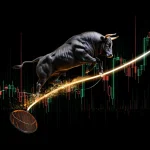
When Fear Gripped the Markets: Can We Avoid Another 2020 Panic?
Dec 10, 2024
In March 2020, as the world grappled with the unfolding COVID-19 pandemic, global stock markets spiralled into a frenzy of panic selling. Investors watched in disbelief as markets plummeted, erasing years of gains in a matter of weeks. Amidst the chaos, a question emerged: Is succumbing to fear the only option, or is there a better way to navigate such turmoil? Could understanding the psychology behind the panic have led to smarter investment decisions?
The stock market panic of 2020 was not just a financial event; it was a profound psychological phenomenon. It revealed how fear can spread like wildfire, prompting mass selling and deepening market losses. Yet, it also showcased the potential rewards for those who remained calm and strategically invested during the downturn. As we reflect on that tumultuous period, the pressing question is: Could it happen again, and how can investors prepare themselves to face similar challenges in the future?
The Chain Reaction of 2020: How Panic Unfolded
The onset of the pandemic triggered unprecedented uncertainty. With economies shutting down and daily life disrupted, fear gripped investors worldwide. Stock markets responded with sharp declines; the S&P 500 fell more than 30% in just a few weeks, marking one of the fastest bear markets in history.
This rapid decline was fueled by herd mentality. As investors saw others selling off assets, many followed suit without fully assessing their own positions. The emotional response overshadowed rational analysis, creating a collective rush for the exits. The sale of stocks became a self-fulfilling prophecy, driving prices even lower.
However, amid the widespread panic, some investors saw an opportunity. Recognizing that the market was oversold, they began buying quality stocks at discounted prices. Their contrarian approach set the stage for significant gains when markets rebounded. This contrast highlights the critical role of investor psychology during market crises.
Herd Mentality: The Dangers of Following the Crowd
Herd mentality occurs when individuals mimic the actions of a larger group, often neglecting their own analysis. In financial markets, this behaviour can amplify trends, leading to bubbles or crashes. The 2020 panic was a textbook case of herd behaviour, where fear prompted mass selling without consideration of underlying fundamentals.
Psychologists explain that in times of uncertainty, people look to others for cues on how to act. This social proof can override personal judgment, resulting in decisions driven by emotion rather than logic. Investors feared being the last to exit, so they sold assets despite long-term investment plans.
The consequence of this behaviour was a market decline that was disproportionate to the economic realities. Companies with strong balance sheets and solid prospects saw their stock prices tumble alongside weaker firms. The indiscriminate selling created opportunities for those willing to step back from the panic and assess the situation objectively.
Behavioral Finance: Understanding Emotional Influences
Behavioural finance explores how cognitive biases and emotions affect investment decisions. Key biases include loss aversion, where the pain of losses outweighs the pleasure of gains, and availability bias, where recent events heavily influence perception.
During the 2020 panic, loss aversion drove investors to sell assets to prevent further losses, even if it meant realizing those losses. Availability bias amplified fears as constant news updates on the pandemic’s impact made the crisis seem insurmountable. In hindsight, this combination led to decisions that were not aligned with long-term financial goals.
By recognizing these biases, investors can work to mitigate their effects. Strategies such as pausing before making significant decisions, consulting with financial advisors, or sticking to a predetermined investment plan can help maintain a rational approach during turbulent times.
Technical Analysis: Tools for Navigating Volatility
Technical analysis involves evaluating statistical trends gathered from trading activity, such as price movement and volume. During market panics, technical indicators can provide valuable insights into when selling may be overdone and buying opportunities emerge.
In 2020, indicators like the Relative Strength Index (RSI) signalled that many stocks were oversold. Moving averages showed long-term upward trends despite short-term declines. Traders who utilized these tools were able to identify entry points that aligned with historical patterns of recovery after sharp declines.
While no method can predict the future with certainty, technical analysis can help investors make more informed decisions. By focusing on data rather than emotions, investors can better assess risk and potential reward during periods of high volatility.
Contrarian Thinking: Capitalizing on Fear
Contrarian investors seek opportunities where others see peril. By going against prevailing market trends, they aim to buy low when pessimism is high and sell high when optimism peaks. This strategy requires patience, courage, and a strong conviction in one’s analysis.
During the 2020 market panic, contrarian investors like hedge fund managers and value investors increased their positions in sectors severely impacted by the pandemic, such as airlines and hospitality. They assessed that these industries would recover in the long term and that the market had overreacted in the short term.
Their bold moves paid off as vaccine developments and economic reopening led to rebounds in these sectors. This approach underscores the potential rewards of contrarian thinking but also highlights the importance of thorough research and risk management.
The Art of Timing: Strategic Entry and Exit Points
Timing the market is challenging, but strategic planning can enhance investment outcomes. Investors can use strategies that adapt to changing conditions rather than attempting to predict exact market tops or bottoms.
One approach is to set target price levels for buying or selling based on valuation metrics. For example, if a stock falls to a price-to-earnings ratio below its historical average, it may signal a buying opportunity. Conversely, it might be time to secure profits if a stock becomes significantly overvalued.
In 2020, investors with predefined criteria for investing were better equipped to act decisively. They avoided being swayed by emotions because objective measures guided their decisions. This disciplined approach can help investors navigate volatility with greater confidence.
Could a 2020-style Panic Happen Again?
Market panics are not new phenomena. History is replete with examples like the 2008 financial crisis and the dot-com bust in 2000. Each event had unique catalysts but shared common threads of fear, uncertainty, and herd behaviour.
Given the unpredictable nature of global events—pandemics, geopolitical tensions, or economic shifts—another panic is always possible. Factors such as high levels of debt, asset bubbles, or rapid changes in technology could trigger market instability.
The key takeaway is that while the triggers may differ, the underlying human behaviours contributing to market panic remain consistent. By understanding these patterns, investors can better prepare for future downturns.
Strategies for Future Preparedness
Preparing for potential market panics involves both mindset and practical strategies. Investors should cultivate patience and resilience, recognizing that market volatility is a normal part of investing. Maintaining a long-term perspective can help keep short-term fluctuations in context.
Diversification is a fundamental principle for managing risk. By spreading investments across different asset classes, sectors, and geographies, investors can reduce the impact of a downturn in any one area. In 2020, portfolios diversified with bonds or gold fared better than those concentrated solely in equities.
Regularly reviewing and adjusting investment plans is also crucial. As personal circumstances and market conditions change, strategies should evolve accordingly. Staying informed about economic indicators and market trends can help investors make proactive adjustments rather than reactive moves driven by fear.
Embracing Education and Professional Guidance
Continuous learning empowers investors to make more informed decisions. Understanding concepts from behavioural finance, technical analysis, and market history provides valuable context for navigating future challenges.
Seeking guidance from financial professionals can also be beneficial. Advisors can offer objective perspectives, help identify biases, and provide tailored strategies based on individual goals and risk tolerance. During panic, having a trusted advisor can make a significant difference in decision-making processes.
Educational resources, webinars, and investment courses are more accessible than ever. By investing time in education, investors equip themselves with tools to better interpret market signals and make decisions that align with their long-term objectives.
Conclusion: Charting a Course Through Uncertainty
The stock market panic of 2020 was a profound lesson in the power of fear and the impact of collective behaviour on financial markets. While it’s impossible to predict or prevent future panics entirely, investors can take steps to mitigate their effects.
Recognizing and understanding the psychological forces at play allows investors to make more rational decisions. Employing strategies like technical analysis and contrarian thinking can uncover opportunities amid chaos. Emphasizing long-term goals over short-term reactions helps maintain perspective when markets become turbulent.
Ultimately, the ability to navigate future market panics lies in preparation, education, and a commitment to disciplined investing. By adopting thoughtful strategies and remaining vigilant, investors can turn potential crises into opportunities for growth. The question isn’t just whether another panic could happen but whether we will be ready to face it with confidence and wisdom.













